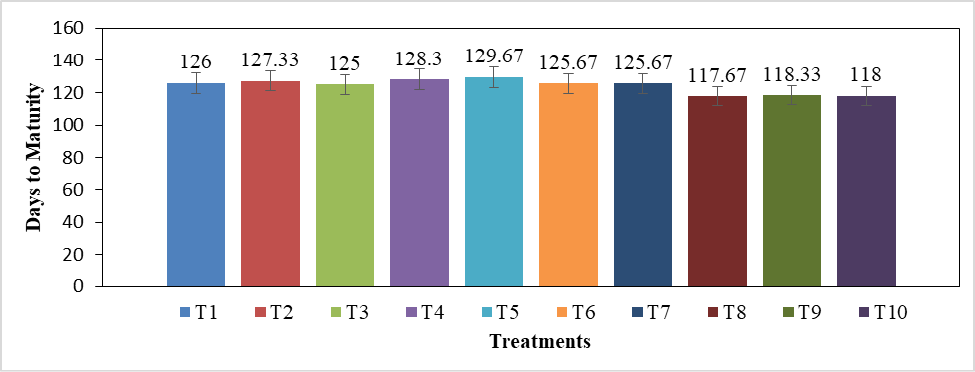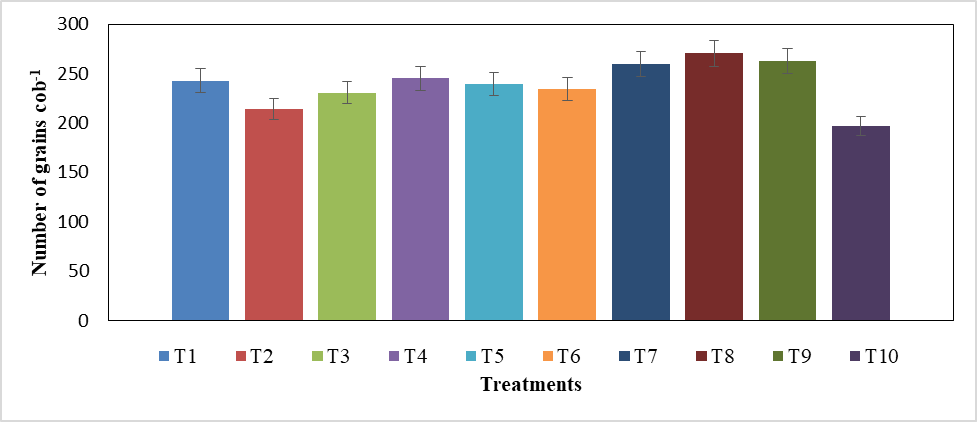Comparison of Organic Mulches with Various Weed Control Strategies for Weed Management in Maize
Huzaifa Hammad1, Bakhtiar Gul1, Haroon Khan1, Muhammad Fawad1*, Hafizullah2, Haidar Ali3 and Tamana Bakht4
1Department of Weed Science and Botany, The University of Agriculture Pehawar, Pakistan; 2University of Chitral, Pakistan; 3Centre for Plant Science and Biodiversity, University of Swat, Khyber Pakhtunkhwa, Pakistan; 4Shaheed Benazir Bhutto University, Sheringal, Upper Dir, Khyber Pakhtunkhwa, 18050, Pakistan.
*Correspondence |Muhammad Fawad, Department of Weed Science and Botany, The University of Agriculture Pehawar, Pakistan; Email: fawadagrarian@aup.edu.pk
Figure 1:
Effect of different treatments on days to 50% tasseling in maize.
T1= Stomp 330 EC as pre-emergence and T2= Atrazine as post-emergence), organic mulches (T3= weeds biomass as mulch), Living mulches (T4= melon (Cucumis melo), T5= water melon (Citrullus lanatus), T6= cucumber (Cucumis sativus), T7= mung bean (Vigna radiata), T8= cowpea (Vigna unguiculata), T9= Weed free treatment as hand weeding and T10= Weedy check
Figure 2:
Effect of different treatments on days to 50% silking in maize.
T1= Stomp 330 EC as pre-emergence and T2= Atrazine as post-emergence), organic mulches (T3= weeds biomass as mulch), Living mulches (T4= melon (Cucumis melo), T5= water melon (Citrullus lanatus), T6= cucumber (Cucumis sativus), T7= mung bean (Vigna radiata), T8= cowpea (Vigna unguiculata), T9= Weed free treatment as hand weeding and T10= Weedy check.
Figure 3:
Effect of different treatments on plant height (cm) of maize.
T1= Stomp 330 EC as pre-emergence and T2= Atrazine as post-emergence), organic mulches (T3= weeds biomass as mulch), Living mulches (T4= melon (Cucumis melo), T5= water melon (Citrullus lanatus), T6= cucumber (Cucumis sativus), T7= mung bean (Vigna radiata), T8= cowpea (Vigna unguiculata)), T9= Weed free treatment as hand weeding and T10= Weedy check.
Figure 4:
Effect of different treatments on dry weed biomass (kg ha-1).
T1= Stomp 330 EC as pre-emergence and T2= Atrazine as post-emergence), organic mulches (T3= weeds biomass as mulch), Living mulches (T4= melon (Cucumis melo), T5= water melon (Citrullus lanatus), T6= cucumber (Cucumis sativus), T7= mung bean (Vigna radiata), T8= cowpea (Vigna unguiculata)), T9= Weed free treatment as hand weeding and T10= Weedy check.
Figure 5:
Effect of different treatments on fresh weed biomass (kg ha-1).
T1= Stomp 330 EC as pre-emergence and T2= Atrazine as post-emergence), organic mulches (T3= weeds biomass as mulch), Living mulches (T4= melon (Cucumis melo), T5= water melon (Citrullus lanatus), T6= cucumber (Cucumis sativus), T7= mung bean (Vigna radiata), T8= cowpea (Vigna unguiculata)), T9= Weed free treatment as hand weeding and T10= Weedy check.
Figure 6:
Effect of different treatments on days to maturity.
T1= Stomp 330 EC as pre-emergence and T2= Atrazine as post-emergence), organic mulches (T3= weeds biomass as mulch), Living mulches (T4= melon (Cucumis melo), T5= water melon (Citrullus lanatus), T6= cucumber (Cucumis sativus), T7= mung bean (Vigna radiata), T8= cowpea (Vigna unguiculata)), T9= Weed free treatment as hand weeding and T10= Weedy check.
Figure 7:
Effect of different treatments on biological yield (kg ha-1) of maize crop.
T1= Stomp 330 EC as pre-emergence and T2= Atrazine as post-emergence), organic mulches (T3= weeds biomass as mulch), Living mulches (T4= melon (Cucumis melo), T5= water melon (Citrullus lanatus), T6= cucumber (Cucumis sativus), T7= mung bean (Vigna radiata), T8= cowpea (Vigna unguiculata), T9= Weed free treatment as hand weeding and T10= Weedy check.
Figure 8:
Effect of different treatments on number of cob m-2 of maize crop.
T1= Stomp 330 EC as pre-emergence and T2= Atrazine as post-emergence), organic mulches (T3= weeds biomass as mulch), Living mulches (T4= melon (Cucumis melo), T5= water melon (Citrullus lanatus), T6= cucumber (Cucumis sativus), T7= mung bean (Vigna radiata), T8= cowpea (Vigna unguiculata), T9= Weed free treatment as hand weeding and T10= Weedy check.
Figure 9:
Effect of different treatments on number of grain cob-1 of maize crop.
T1= Stomp 330 EC as pre-emergence and T2= Atrazine as post-emergence), organic mulches (T3= weeds biomass as mulch), Living mulches (T4= melon (Cucumis melo), T5= water melon (Citrullus lanatus), T6= cucumber (Cucumis sativus), T7= mung bean (Vigna radiata), T8= cowpea (Vigna unguiculata), T9= Weed free treatment as hand weeding and T10= Weedy check.
Figure 10:
Effect of different treatments on grain yield (kg ha-1) of maize crop.
T1= Stomp 330 EC as pre-emergence and T2= Atrazine as post-emergence), organic mulches (T3= weeds biomass as mulch), Living mulches (T4= melon (Cucumis melo), T5= water melon (Citrullus lanatus), T6= cucumber (Cucumis sativus), T7= mung bean (Vigna radiata), T8= cowpea (Vigna unguiculata), T9= Weed free treatment as hand weeding and T10= Weedy check.
Figure 11:
Effect of different treatments on harvest index (%) of maize crop.
T1= Stomp 330 EC as pre-emergence and T2= Atrazine as post-emergence), organic mulches (T3= weeds biomass as mulch), Living mulches (T4= melon (Cucumis melo), T5= water melon (Citrullus lanatus), T6= cucumber (Cucumis sativus), T7= mung bean (Vigna radiata), T8= cowpea (Vigna unguiculata), T9= Weed free treatment as hand weeding and T10= Weedy check.




















